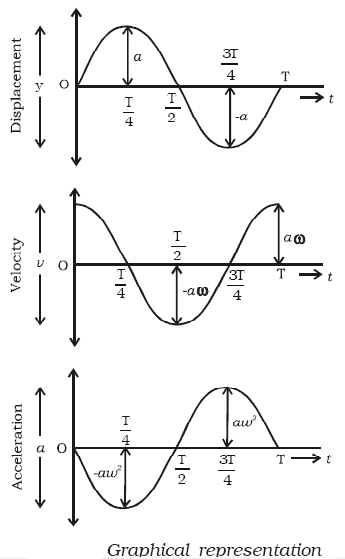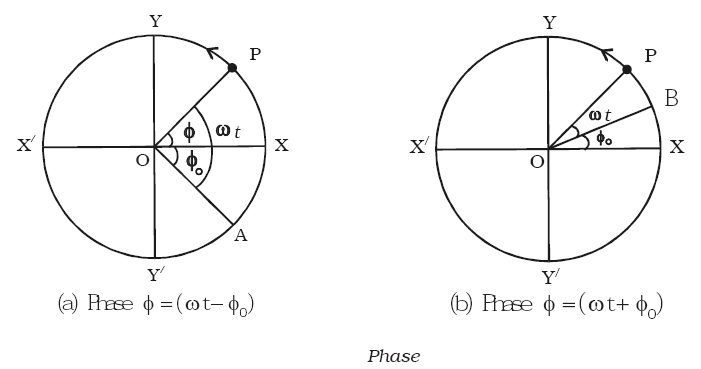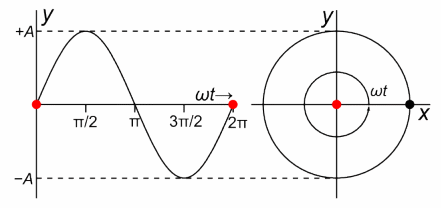Graphical Representation of S.H.M

Graphical representation of displacement, velocity and acceleration of a particle vibrating simple harmonically with respect to time t is shown in figure.
(i) Displacement graph is a sine curve. Maximum displacement of the particle is y = +a.
(ii) The velocity of the vibrating particle is maximum at the mean position i.e v = + a ω and it is zero at the extreme position.
(iii) The acceleration of the vibrating particle is zero at the mean position and maximum at the extreme position (i.e) ∓a ω2.
The velocity is ahead of displacement by a phase angle of π/2 . The acceleration is ahead of the velocity by a phase angle π/2 or by a2 phase π ahead of displacement. (i.e) when the displacement has its greatest positive value, acceleration has its negative maximum value or vice versa.
Important terms in simple harmonic motion
(i) Time period
The time taken by a particle to complete one oscillation is called the time period T.
In the figure, as the particle P completes one revolution with angular velocity ω, the foot of the perpendicular N drawn to the vertical diameter completes one vibration. Hence T is the time period.
Then ω = 2π/T or T = 2π/ω
The displacement of a particle executing simple harmonic motion may be expressed as
y(t) = a sin (2π/T) t …... (1)
and y(t) = a cos (2π/T) t …... (2)

Here T represents the time period, a represents maximum displacement (amplitude).
These functions repeat when t is replaced by (t + T).
y (t+T) = a sin [2π/T (t +T)] …... (3)
= a sin [2π (t/T) + 2π]
= a sin 2π (t/T) = y (t)
Generally, y (t + nT) = y (t )
Above functions are examples of periodic function with time period T. It is clear that the motion repeats after a time T =2π/ω where ω is the angular frequency of the motion. In one revolution, the angle covered by a particle is 2π in time T.
(ii) Frequency and angular frequency
The number of oscillations produced by the body in one second is known as frequency. It is represented by n. The time period to complete one oscillation is 1/n.
T = 1/n shows the time period is the reciprocal of the frequency. Its unit is hertz. ω = 2πn, is called as angular frequency. It is expressed in rad s−1.
(iii) Phase
The phase of a particle vibrating in SHM is the state of the particle as regards to its direction of motion and position at any instant of time. In the equation y = a sin (ωt + φo) the term (ωt + φo) = φ, is known as the phase of the vibrating particle.
Epoch

It is the initial phase of the vibrating particle (i.e) phase at t = 0.
Thus, φ = φo (∵ φ = ωt + φo)
The phase of a vibrating particle changes with time but the epoch is phase constant.
(i) If the particle P starts from the position X, the phase of the particle is Zero.
(ii) Instead of counting the time from the instant the particle is at X, it is counted from the instant when the reference particle is at A as shown in figure. Then ∠XOP = (ωt – φ0)
Here (ωt − φo) = φ is called the phase of the vibrating particle. (– φ0) is initial phase or epoch.
(iii) If the time is counted from the instant the particle P is above X (i.e) at B, [as shown in figure] then (ωt + φo) = φ. Here (+φo) is the initial phase.
Phase difference

If two vibrating particles executing SHM with same time period, cross their respective mean positions at the same time in the same direction, they are said to be in phase.
If the two vibrating particles cross their respective mean position at the same time but in the opposite direction, they are said to be out of phase (i.e they have a phase difference of π).
If the vibrating motions are represented by equations
y1 = a sin ωt and y2 = a sin (ωt − φ)
then the phase difference between their phase angles is equal to the phase difference between the two motions.
∴ phase difference = ωt − φ − ωt = −φ negative sign indicates that the second motion lags behind the first.
If y2 = a sin (ωt + φ),
phase difference = ωt + φ − ωt = φ
Here the second motion leads the first motion.
We have discussed the SHM without taking into account the cause of the motion which can be a force (linear SHM) or a torque (angular SHM).
Some examples of SHM
(i) Horizontal and vertical oscillations of a loaded spring.
(ii) Vertical oscillation of water in a U−tube
(iii) Oscillations of a floating cylinder
(iv) Oscillations of a simple pendulum
(v) Vibrations of the prongs of a tuning fork.
Refer this video to know more about, “Graphical Representation of S.H.M”.
|
|
Problem (JEE Main):
Force constant of a weightless spring is N/m. A body of mass 1.0 kg suspended from it is pulled down through 5 cm from its mean position and then released. The maximum kinetic energy of the system (spring+body) will be (0.0x) J. Find value of x.
Solution:
We know that,
ω = √(k/m) = √(16/1) = 4 rad/s
Now, Kmax = ½ mω2A2
= ½  1
1 42
42  (5
(5 10-2)2 = 2
10-2)2 = 2 10-2 J
10-2 J
From the above observation, we conclude that, the value of x will be, 2 10-2 J.
10-2 J.


Question 1
A simple harmonic oscillation has
(a) fixed frequency and fixed amplitude.
(b) fixed frequency and variable amplitude.
(c) variable frequency and fixed amplitude.
(d) variable frequency and variable amplitude.
Question 2
A simple harmonic oscillation of a given system can be specified completely by stating its
(a) amplitude, frequency and initial phase.
(b) amplitude, frequency and wavelength.
(c) frequency and wavelength.
(d) frequency, wavelength and initial phase.
Question 3
The frequency of a body moving with simple harmonic motion is doubled. If the amplitude remains the same, which one of the following is also doubled?
(a) the time period (b) the total energy
(c) the maximum velocity (d) the maximum acceleration
Question 4
Which one of the following statements concerning the acceleration of an object moving with simple harmonic motion is correct?
(a) It is constant
(b) It is at a maximum when the object moves through the centre of the oscillation.
(c) It is zero when the object moves through the centre of the oscillation.
(d) It is zero when the object is at the extremity of the oscillation.
Question 5
Which one of the following gives the phase difference between the particle velocity and the particle displacement in simple harmonic motion?
(a) π/4 rad (b) π/2 rad
(c) 3π/4 rad (d) 2π rad


| Q.1 | Q.2 | Q.3 | Q.4 | Q.5 |
|
a |
a |
c |
c |
b |
Related Resources:-
-
You might like to Vibration of air column in pipes.
-
For getting an idea of the type of questions asked, refer the Previous Year Question Papers.
-
Click here to refer the most Useful Books of Physics.
-
To get answer to any question related to graphical representation of simple harmonic motion click here.

